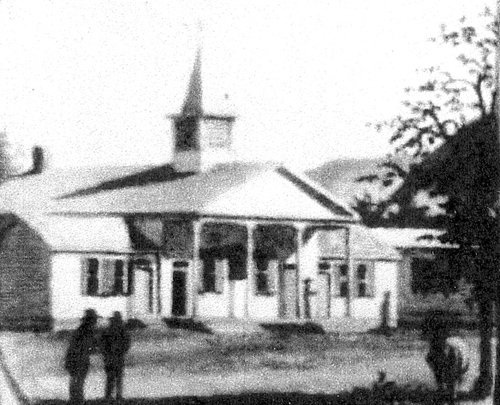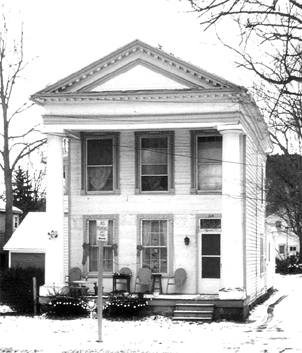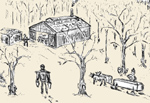|
The Moving of Bath
by
This title, "The Moving of Bath," refers to the relocation of many houses,
barns and other structures during the village's growth. Many were moved
to make room for new buildings. In the rapidly growing settlement, businesses
required larger accommodations. Some inadequate buildings were still usable
and could be moved. Residences, too, were moved away from busy streets.
Sometimes a part of a large house was moved to an adjoining lot to become
a separate residence. A house on East Morris Street was set over to its
lot line and close to a neighboring house to make room for the new Delaware
Avenue, and a large house on East Steuben Street was moved 100 feet side-ways
to provide space for a larger lawn. A house on East William Street was
turned to face a different direction. Several barns were moved and converted
into residences.
James Hope is the person in Bath who knows which structures have been
moved. Jim's knowledge comes not only from his own memory and recollections
of acquaintances but also from his familiarity with village records and
newspaper accounts as the long-time town and then village historian of
Bath, and former Steuben County Historian. Jim likes to point out to interested
friends the buildings that at one time stood in another place. To compile
a record of the transplanted buildings, Dr. Joseph Paddock and Bill Treichler
went on several excursions around Bath with Jim noting places and dates.
Joe Paddock later took a photograph of each building. From these notes
and additional sources we intend to assemble a series of articles on the
moving of various buildings in the village of Bath. We need to identify
these structures and record their relocation as a vital part of the history
of the village. Some of these buildings were among the first constructed
in the early years of the settlement. They are a record in themselves,
and they are testimony to the skills of their builders. The very earliest
cabins were laid up with logs, but soon timber-frame structures were erected.
Built like a box, with heavy sills and posts hewn from logs, connected
by mortise and tenon joints, and stiffened with angle braces, the frames
were strong enough to remain square and solid on minimal foundations subject
to frost heaving and settling.
Timber-framed structures are sufficiently strong and resilient to be
skidded over frozen, snow-covered ground or to be jacked up using cribbing
until log rollers or wheel sets could be placed underneath and the whole
towed or drawn with a windlass to a new site.
This series about transplanted buildings begins with the wood-framed
court house put up on the square in Bath by the Pulteney Group in 1797.
Early accounts describe the erection, the several uses, the remodelings
of the court house, and its removal in 1827. Although there is no official
documentation of the building's continued use, local people generally
believe that part of the first court house became a residence that still
stands at 226 East Steuben Street. One wing was said to have been moved
to a location near the cemeteries on East Morris Street.
The first builders who came with Williamson to construct a new city in
the wilderness undoubtedly brought construction techniques and design
traditions, as evidenced by the durability of their constructions, and
their use of classical proportions and details. Sawmills set up along
the Conhocton River busily sawed out scantlings for framing walls and
boarding for flooring and cladding. The court house was one of the earliest
framed buildings built on Pulteney Square. It was described as having
a one and one-half story central part with one or two wings. This is confirmed
by a crude drawing in the early sketch of Bath showing the eaves of the
central section above the peak of a wing roof, a simple and practical
design.

Bath from 1824 to 1828 - Its Old Court House
Picture courtesy of the Steuben County Historical Society
Following are accounts of the first court house by Henry W. Rogers, Ansel
J. McCall, and James S. Drake, Jr., and from an architectural survey of
Bath, New York.
Henry W. Rogers
Ann Arbor, Jan. 25, 1879
To the Editor of The Advocate:
When I went to Bath, the Courts were held in the old court house where
the present one now stands. It was a wooden structure of hardly two full
stories, with a veranda and pillars facing Pulteney Square, and, it seems
to me with wings on the north and south sides. But in this, my wife thinks
I am wrong, and very likely I may be. There were no churches or public
halls in the village, and the court house was used for religious public
services regularly on the Sabbaths, and during the week, when no court
was sitting, for the holding of political and other meetings for concerts,
lectures, theatrical performances, and in short, for pretty much every
thing.
I recollect that a company of theatrical tramps (or strolling players,
as they were then called) came through the country, I think in the fall
of '24, and making Bath an objective point for their operations obtained
from the sheriff the privilege of putting up their scenic apparatus in
the court house, and for a number of consecutive nights ran a theatre
for the instruction and edification of the villagers. It was the first
attraction of the kind the village had been honored with, as I understood.
However that may have been, the occasion was one of exciting interest
and the theatre was extensively patronized. The children and most of the
women attended, and all the men, with the probable exception of Parson
Higgins and his ruling Elders. One of the pieces played was Colman's Farce
of The Heir at Law, in which one of the characters, a king of pedantic
absurdity, describes himself as Dr. Peter Pangloss, L. L. D., A. S. S.*
I think I can now see that the latter Degree, which very likely was the
creation of the author of the play, might have been conferred upon most
of those in attendance, with quite as much propriety as upon Dr. Pangloss.
It was the first opportunity I had had of seeing theatrical exhibitions
unless Sicklers' show of The Babes in the Woods, may be regarded as an
exception and this no doubt was true of a large majority of the villagers
at that day.
* Artium Sociatatis Socius
From the Historical Address of
Ansel J. McCall, Esq., June, 1893 from
The Centennial of Bath, New York, 1793-1893
[page 123]
—1797 The Court House and jail were completed this year. The Court
House was a wooden structure a storey and a half high, with a portico,
flanked by wings and located on the east side of Pulteney Square. It was
built at Pulteney's expense. It was a neat and commodious structure well-suited
for the purpose for which it was intended. The first record we have of
its occupancy by the court was at the June term of 1798. One of the wings
of the old one, when the new Court House was built in 1827, was moved
to the lower part of Morris Street and fitted up for a dwelling on the
property of the late Matthew Shannon where it stood until a few years
ago.
[page 133]
—In 1827, the old wooden Court House erected by Colonel Williamson
on the east side of Pulteney Square, was removed and replaced by a large
two- story one of brick.
Jim Drake was County Attorney for Steuben County from 1930 to 1961.
He collected facts about the county, wrote many essays on the history,
towns, highways and events in the county, and he compiled chronologies
of county history he titled, "Some Firsts and Some Seconds." Mr. Drake
passed out copies of these to people attending the county fair.
Following are excerpts that mention the courthouse:
—1794 Williamson had Pulteney Square cleared and a blockhouse built
in the center. Williamson built a one-story frame courthouse erected on
the site of the present courthouse and a log jail on the opposite side.
News of the victory at Fallen Timbers [prompted Williamson] to tear
down the blockhouse and start to blow up the bubble [the promotion of
Bath] by erecting some forty log houses, a theatre, a race track laid
out, and farm buildings with stock for ready- made farms for sale.
Pulteney Estate conveyed to the county the lot on the west side of the
square together with the jail erected theron 'and for the courthouse of
said county for ever.'
The courthouse in Bath was made a story and a half high with a steeple
and windows replaced at a cost of $215.00.
The custody of the courthouse was placed in the sheriff, who was to see
that 'all persons are excluded from using said house as a storage house
or school house, or for any other private use.'
The second floor of the courthouse could be used by the local Masonic
lodge 'if they would do the necessary fixing.'
A bell and lightning rods were purchased for the courthouse in Bath.
—1816 The courthouse in Bath could not be used for religious purposes
of any kind.
The first peace-time militia company of infantry was organized for membership
from the whole county. The state declined to furnish equipment, because
under the law they were to equip themselves. Someone remembered that in
1813 the county clerk received a considerable number of arms and ammunition
just in case it was necessary to be used in the War of 1812. These were
found stored in the basement of the courthouse and the county purchased
added equipment and caused them to be distributed to the so-called 'arsenals'
located in Addison, Avoca, Bath, Campbell, Cohocton, Corning, Greenwood,
Prattsburgh, Pulteney, Rathbone, Wayland and Woodhull for the use of the
militia company and starting in 1851 for use on 'training day' for all
men between the ages of 18 and 45. The county paid considerable funds
each year for cleaning the equipment and several resolutions expressed
a desire to do away with the barns used as arsenals and have an armory
erected.
—1824 The courthouse in Bath was finished off on the second floor
and Solah Barnard leased it for a law office for an annual rental of necessary
wood fuel to heat the entire building.
—1826 The frame story-and-half courthouse in Bath with its pillars
added in 1824 was removed to 226 East Steuben Street, where it still stands.

226 East Steuben Street, Bath, New York.
Photograph by Joseph Paddock
Condensed from information about 226 East Steuben Street, Bath, collected
during a survey of buildings in Bath and described by Roger G. Reed
on a Building-Structure Inventory Form, Division For Historic Preservation,
New York State Parks and Recreation.
Roger Reed states that it is known that a building did not appear on
this site until sometime between 1857 and 1869. The owner, Louis Walzmiller
(Welzmiller), was a cabinet maker in 1891. Two relatives John Walzmiller,
a druggist, and Louis J. Walzmiller, a designer, lived with Louis and
his family. After Louis died, his wife Marie and son Charles sold the
house in 1919.
Mr. Reed records that Sanborn insurance maps show that the house was
remodeled between 1904 and 1915 when large wings were removed from the
east and south sides and a small wing added to the east side.
Reed suggests that a close examination of the structure in the attic
of the building might resolve the origin of the building. He does point
out the more ornate trim of the second story windows which indicates the
upper part of the building may have been salvaged. He also points out
that a pedimented portico supported by two widely-spaced columns, as on
this house, is a prominent feature of two buildings facing Pulteney Square:
the present Court House and the building across the square that was the
Steuben County Bank. Is this architectural treatment unique to Bath?
| 


